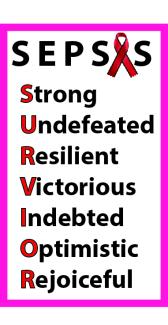
I have only brief memories of my time spent in ER and ICU. I suffered hallucinations of being extremely fearful that I was in danger from the staff and those around me. At one point I grabbed the nurse’s cell phone and called 911 to come and help me. This was a difficult time for my family. In spite of their efforts I could not be reassured, and the uncertainty of my condition was heart wrenching for them.
It was confirmed I had multiple abdominal pelvic abscesses (pockets of infected fluids in the belly), requiring multiple kinds of antibiotics to treat. After 5 days in the ICU I was stabilized and transferred to a surgical unit. My kidneys were recovering and a drainage had been inserted into my abdomen.
2 weeks later, while still in our local hospital, I became ill again. I was transported to a much larger acute care hospital. Here I developed a substantial enterocutaneous fistula, an abnormal connection between the stomach or intestines and skin that causes the contents of the digestive track to leak into the skin. I required a catheter, and all my nutrition was from intravenous fluids. Another drain was inserted into my abdomen as the abscesses were not resolving. My lungs were failing, and I developed pneumonia and a nasty bed sore that was not noted in previous care facility until a few days before my transfer.
All in all, I was hospitalized 58 days. Sepsis is a life-altering event. I am humbled and mindful of how precious life can be. Sepsis is not just a patient-centered illness; it can devastate and exhaust family members. The physical, emotional, spiritual and economic struggles are real for not only the patient, but those that love them. I was so fortunate to have so much loving support.
It was a long recovery. I was fortunate to have my sister move in with us during this time. At one point I couldn’t even stand due to severe muscle atrophy. With lots of physiotherapy I was able to walk short distances using a walker. Fatigue was overwhelming. My already thin and short hair fell out. My skin, especially on my feet, was shedding like snow on a winter’s day. I struggled with concentration and brain fog. It took a few months before we all felt I was independent enough for my sister to return to her own home and life. Insomnia is still my biggest issue and I am still haunted by the memories of it all. I required additional major surgery about a year later to close the fistula and repair yet another hernia. Fear of sepsis was my enemy, and I required lots of reassurance and mental health support. I am pleased to say all went well and I am currently on a successful path to recovery.
I was a nurse and knew about sepsis, but truly did not fully understand or know how common and catastrophic the effects can be, both in the short- and long-term. It is my hope that I can continue to support and advocate for sepsis awareness, education and changes to protocols to help mitigate and improve outcomes for all sepsis patients and their families.
